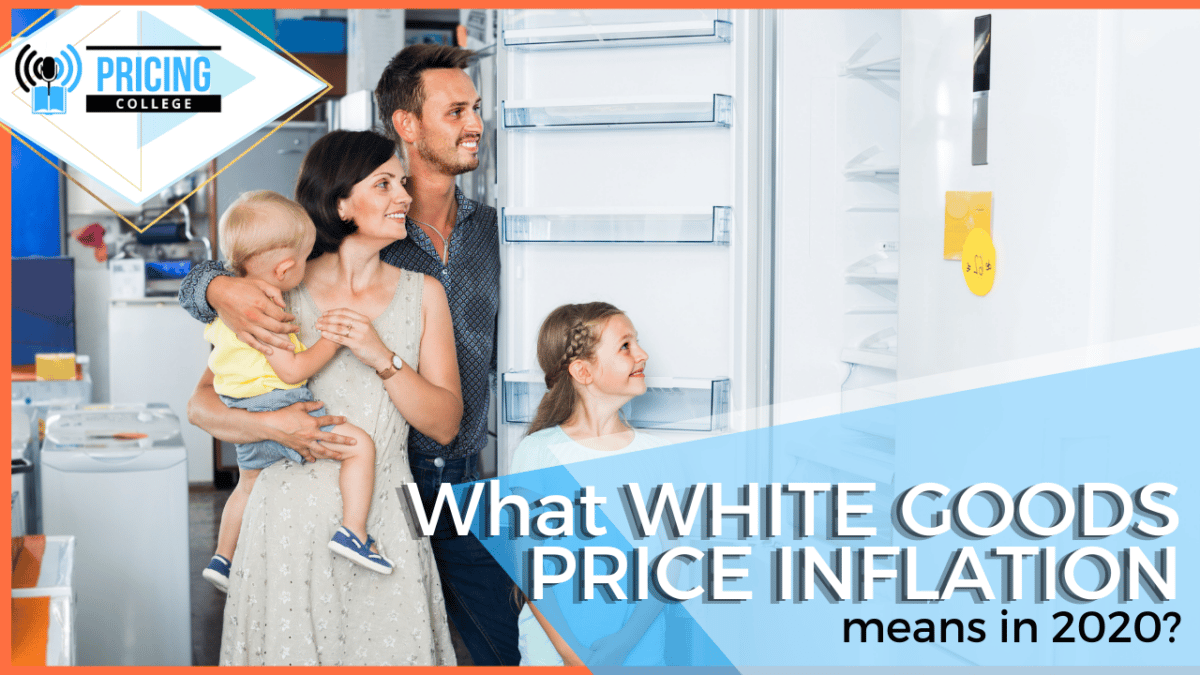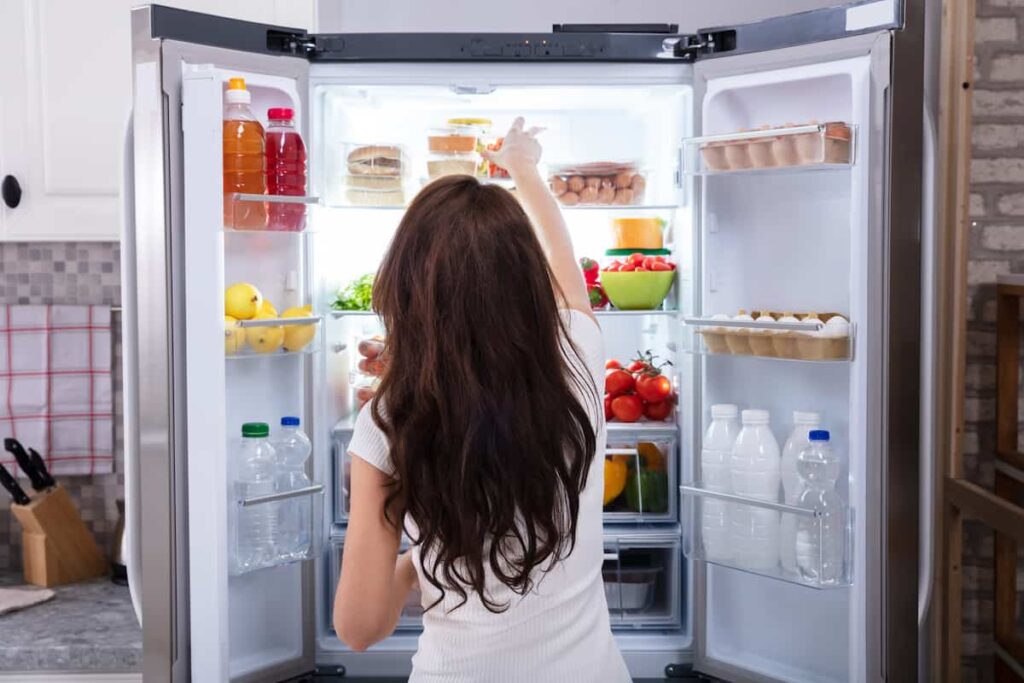
White Goods Price Inflation 🔖 Podcast Ep. 94
We are covering the typical question that is in the press relating to white goods price.
The pricing on white goods such as washing machines, fridges, that sort of thing is increasing apparently for the first time in almost a decade.
Listen on Apple Podcasts Listen on Spotify Listen on Google Podcasts Listen on Stitcher Listen on Amazon Music
TIME-STAMP SHOW NOTES
[00:00] Introduction
[00:47] Joanna explains the reasons why the white goods price didn’t increase over a decade and why are they increasing now
[02:24] Through the years, features and benefits of white goods products significantly improved. Aidan argues that white goods price also increased over the years
[04:30] Manufacturing companies do ranging with their white goods, product strategy by using good, better, best, best-plus, or most ultra-premium. How does it affect white goods’ price?
[05:57] White goods products such as fridges are becoming a status symbol
[08:17] With an ultra-premium product range in a white good market, what pricing strategy are they using?
[10:27] The future of white goods products – Are they going to rely more on technology and digitalisation?
White goods price hasn’t increased in a decade
Yes, seems like everything’s in crisis, prices are increasing at the moment. It’s in the press a lot across the board. But we were particularly interested in white goods because as Aidan says, they haven’t increased for a number of years now – but a decade.
So why now? I think just to start off, why didn’t they take the price increase?
I think, looking at it in terms of often businesses look at this in terms of their costs. And I think it’s much easier to reduce costs, through manufacturing. A different type of input cost material costs reductions those sorts of things. Then to increase the retail price to customers.
So often that has been the general way of maximising margins. I think though, over the past few months, that hasn’t been possible with fluctuating input, material costs, effects changes, and also changes in customer preferences. People want different types of fridges and all those white goods. They don’t want the same old.
So, that changes the manufacturing process as well. But starting with that first one, let’s just really examine that sort of cost implications. There has been very much a focus on that. And as a response, they’re not really thinking much about the customer and moving with the times.
I think with inflation kicking off, something people have forgotten about, clearly, that explains why these companies are pushing prices up.
One of the things though that surprised me when I read these news stories were the prices had not increased in 10 years. I’ll be honest, I actually doubt that that’s true.
Just from visiting Harvey Norman is one of the big retailers here in Australia that sells those sorts of white goods. It’s actually very interesting to walk around those areas where you’re seeing the washing machines, dishwashers, microwaves, all those sorts of items.
And what I will say is the just the quality of these machines has improved. The water efficiency, the electricity efficiency, the features they’re through the roof.
So, they’re infinitely better than what was standard 10 to 15 years ago.
To some extent, I was very surprised to hear this. I actually doubt the prices have stayed static. I actually think that significantly increased. Even items such as televisions, which I’m not sure if they fall into the white goods category.
But if we stick even to fridges 10 or 15 years ago, a standard fridge it was a white good. It was not very many bells and whistles. Now they have icemakers that are reasonably standard in many, you can chill water dispensers.
You have the American style fridge which is still reasonably new in Australia. Where the large, almost designer style fridges. You have ridiculous new aspects such as touchscreens and temperature monitors. Aspects where you can change category compartments from freezer to just chilled.
So, the actual features and benefits of the product have increased many times over.
They’re infinitely better than they used to be. I also personally think the prices have gone up significantly also.
So I do think I’d like to look a bit more detail into…
- What does that actually mean?
- How they’re categorised is pricing static?
- And, if it actually is accurate?
How do product ranges affect the white goods price?
I think in regards to that, I know you’re saying I think that has to do with range. They are changing their product strategy by using a sort of like good, better, best, best plus or most ultra-premium by introducing all the bells and whistles with these almost computerised fridges.
Whether or not yes, the prices are much higher than the standard fridge. But I actually speculate…
- Are they high enough for what they actually offer?
- Or are they putting those premium sorts of fridges out there to test demand?
Because I just can’t imagine there’s a huge demand out there for an 8000 grand fridge. But have as we have seen in other industries at the moment since COVID, there have been bubbles of demand in that middle-class population who want premium goods.
So, actually, what we could be seen as a raging strategy. That is keeping up to date with demand for absolute premium and luxury. However, we haven’t got any past data on that.
So how long would that bubble last?
But there aren’t huge amounts of premium fridges in the market to know that. I think overall still you’ve got your standard fridges on the bulk of the market.
That is where I think they’re keeping their cost and price competitive. And that’s where the stability has been with a price. And that’s where the major price increase, the controversial price increase is occurring now.
So overall, the whole category of fridges is being moved up. And I think that’s been dragged up by this ultra-premium range.

White goods products are becoming a status symbol
You’re not going to hear any argument from me on that one. I think that hits it. I think, yeah, you’ve got your standard fridge that chills food and then you have it’s almost a status symbol.
And I think maybe COVID is exacerbated the way we live. Again, my views here could be based on watching 1950s and 60s television shows. But I think in which that’s where everyone’s education comes from.
But I think that most people had dinner parties in that era. The guests didn’t congregate in the kitchen from what I’ve watched in those sorts of TV shows. People had their dinner in the dining room and people the hosts will bring the food through. Whereas I think no, and again, this is based on watching TV shows.
I think people are entertained more in these luxury kitchens than they have. The kitchen is always a focal point in the house which is a change in living style. You have granite tops. You have an island in the kitchen. And, you have designer sinks with two sinks, and the ovens and all these sorts of things.
It’s almost like an entertainment entertaining space. It’s almost like a status symbol were to show how much stuff you have.
It used to be, “Here’s my car.” Now it’s “Look at my fridge!”
I think if you have this fancy kitchen, you do need to have a fancy fridge. You want your ice compartments and you want something to show off.
So yeah. I think these things used to be, the white goods used to be stapled, they used to be utilities or basics. Now, I think as Joanna mentioned I think you have obviously you still have that and that’s where cost-plus and inflation are kicking in.
But I think you’ve probably got the Bugatti and the Rolls Royces or fridges now also that those people caught up for. Then you also have some of these, I think they’re washing machines somewhere that as German manufactured. Where they’re so high tech, they’re almost like chocolate cheese.
With the ultra-premium white goods price, are they using a skimming pricing strategy?
The interesting thing will be when they find as I was saying before, that there’s not a huge demand for that ultra-premium now they’re still more demand for the standard offer.
So the manufacturing is still done around that. But if that demand does shift, so to operations and all that value manufacturing will have to change.
Then it’ll become interesting. And then there’ll be more price changes with that as well I suppose. But I think it really is a trial. I am quite interested to see how they’ve calculated prices for the ultra-premium range.
Have they adjusted the conventional skimming strategy to start high?
It’s novel, we’ve got a computer that basically almost speaks to you. We think that as a manufacturer of those ultra-premium goods is going to be novel. People don’t really fully understand it. When people don’t fully understand it, research shows more likely to spend more money on it.
But as the market matures and they understand the offer, then it decreases. I wonder if they’re using that as their main guiding principle to pricing or whether they’re using more sophisticated value-based approaches and thinking about as Aidan was going on about like those specifications of the product.
- What does that mean to the customer?
- Has the market research on customer usage really been explored?
- And how’s that been interpreted into the price calculations?
So those sorts of things are intriguing to me as a pricing expert in that space. But at the same time, I think it’s pretty much a wait and see. Markets changing hugely now COVID restrictions are lifting people are travelling.
Disposable income in household goods probably will decrease. What does that mean?
Well for white goods, innovation in that space, slow down and will be ranging change back to normal. I don’t think obviously now we’ve got introductions to new premiums that offer. There’s always gonna be people that are going to buy it. But, at what pace is the question?
Bottomlime: The digitalisation of white goods products
I just got one more point to make. I think it’s related to this idea of the internet of things. And I only became aware of this in relation to white goods when I was browsing as mentioned in the shop.
I think some of the fridges now…
- They can check what’s in the fridge.
- They’re hooked up to the internet and they can suggest recipes or meals that you could make from those five items in the fridge.
- They can tell you food is expiring if it’s going off or if you need to buy more.
What almost inevitably will happen is there will be tie-ups between the white good companies, between the fridges, between unconstrained fridges here. But it will apply to others also.
But you’ll have the fridges they’ll be linked up to online shopping through the supermarket or through delivery companies, Marley spoon or HelloFresh or one of these sorts of companies. And I think you’re only a couple of years away really from an integrated food provision service.
Whereby your fridge is more of this network concept in which rather than just buying a fridge to store food, you are buying a meal delivery.
It’s almost like just in time sort of delivery process or logistics almost to get the food straight to your belly, almost. Let’s be honest. So, I think that’s the way it will go. I think you’ll see these companies tie up more and more. There’ll be automatic ordering.
It’ll probably automatically learn…
- How do you eat?
- What do you like?
- How do you consume quickly?
It’ll order stuff in advance for you. It might even give you treats on your birthday by ordering birthday cakes. All that sort of stuff is just around the corner. And yeah, when you get into that the pricing equation changes. I don’t think we’ll be talking about costs plus.
For a comprehensive view on building a great pricing team to prevent loss in revenue,
Download a complimentary whitepaper on How to Build Hiring Capability To Get The Best Pricing Team
〉〉〉 Contact Us for a FREE Consultation〉〉〉
Related Posts
Leave a Reply Cancel reply
Categories
- marketing strategy (26)
- Organisational Design (14)
- Podcast (114)
- Pricing Capability (87)
- Pricing Career Advice (10)
- Pricing Recruitment (19)
- Pricing Strategy (289)
- Pricing Team Skills (13)
- Pricing Teams & Culture (24)
- Pricing Transformation (47)
- Revenue Model (25)
- Sales Effectiveness (27)
- Talent Management (7)
- Technical Pricing Skills (35)





